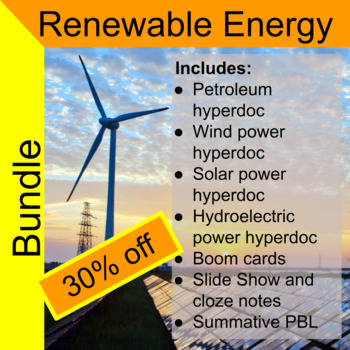Energy Bundle - 30% off!
JayZee
271 Followers
Grade Levels
4th - 8th
Subjects
Resource Type
Standards
NGSSMS-ESS3-4
NGSSMS-ESS3-3
Formats Included
- Google Docs™
JayZee
271 Followers

Includes Google Apps™
This bundle contains one or more resources with Google apps (e.g. docs, slides, etc.).
Products in this Bundle (9)
showing 1-5 of 9 products
Description
Bundle includes:
- hyperdocs for:
- Petroleum
- Wind Power
- Solar Power
- hydroelectric power (Virtual tour of Hoover Dam)
- Boom card deck on alternative energy
- Slide Show for alternative energy (PPT and Google Slides) with cloze notes (Google Doc)
- Energy Sources PBL - design an island resort and choose the type of energy to power it
Related Products
• Alternative Energy Cloze Notes (Google Docs)
• Alternative Energy Cloze Notes - MS Word
• Alternative Energy Slide Show (Google Slides)
• Alternative Energy Slide Show (PowerPoint)
• Energy Sources Color By Number PDF
• Energy Sources Problem Based Activity PBL -Middle School - Distance or In Person
Total Pages
Answer Key
N/A
Teaching Duration
2 Weeks
Report this resource to TPT
Reported resources will be reviewed by our team. Report this resource to let us know if this resource violates TPT’s content guidelines.
Standards
to see state-specific standards (only available in the US).
NGSSMS-ESS3-4
Construct an argument supported by evidence for how increases in human population and per-capita consumption of natural resources impact Earth’s systems. Examples of evidence include grade-appropriate databases on human populations and the rates of consumption of food and natural resources (such as freshwater, mineral, and energy). Examples of impacts can include changes to the appearance, composition, and structure of Earth’s systems as well as the rates at which they change. The consequences of increases in human populations and consumption of natural resources are described by science, but science does not make the decisions for the actions society takes.
NGSSMS-ESS3-3
Apply scientific principles to design a method for monitoring and minimizing a human impact on the environment. Examples of the design process include examining human environmental impacts, assessing the kinds of solutions that are feasible, and designing and evaluating solutions that could reduce that impact. Examples of human impacts can include water usage (such as the withdrawal of water from streams and aquifers or the construction of dams and levees), land usage (such as urban development, agriculture, or the removal of wetlands), and pollution (such as of the air, water, or land).





